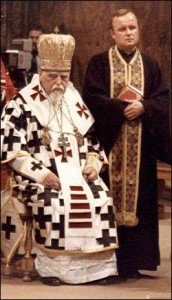In 1596, in exchange for certain guarantees, a small group of Ukrainian Orthodox bishops agreed to recognize the authority of the Bishop of Rome. From the perspective of the Ukrainian bishops who signed the Union, its main import was to ensure retention, in toto, of the ritual, liturgical usage and discipline of its Church and that all of these matters be left in their own hands and jurisdiction. There were no doctrinal or dogmatic difficulties to be resolved. To them, Union with the Holy See consisted simply shifting ecclesiastical jurisdictional dependence from the Patriarch of Constantinople to the Patriarch of Rome.
 The Holy See concurred completely on all counts and gladly guaranteed that all liturgical matters would be left to the Ukrainian prelates and their successors. To quote from the official Constitution of Pope Clement VIII of 23 December 1595 regarding the Union: we receive, unite, join, annex and incorporate our members in Christ, and to enhance more greatly the meaning of our love for all the sacred rites and ceremonies themselves, which the bishops and clergy use, as established by the holy Greek Fathers in the Divine Offices, in the Holy Sacrifice of the Mass and in the administration of the rest of the Sacraments and other sacred functions…with Apostolic graciousness we permit, concede and allow (them) to the same Ruthenian [Ukrainian] bishops and clergy….”
The Holy See concurred completely on all counts and gladly guaranteed that all liturgical matters would be left to the Ukrainian prelates and their successors. To quote from the official Constitution of Pope Clement VIII of 23 December 1595 regarding the Union: we receive, unite, join, annex and incorporate our members in Christ, and to enhance more greatly the meaning of our love for all the sacred rites and ceremonies themselves, which the bishops and clergy use, as established by the holy Greek Fathers in the Divine Offices, in the Holy Sacrifice of the Mass and in the administration of the rest of the Sacraments and other sacred functions…with Apostolic graciousness we permit, concede and allow (them) to the same Ruthenian [Ukrainian] bishops and clergy….”
While the Union was intended to ensure the retention of the spiritual and liturgical practices of the Ukrainian Greek Catholic Church, the reality is that it resulted in the separation of sacramental theology from moral and dogmatic theology that emerged in the Christian West through Thomism and Scholasticism after the Reformation. This was unknown in the Christian East. It is difficult to draw any precise line between these disciplines as far as Eastern Christianity is concerned. Indeed, it is questionable whether such a division can even be profitably attempted. Rather than segmenting various theological categories, the entire ecclesiological life of the Eastern Christian Churches is inextricably intertwined in the total Christian life of prayer and, in every case – liturgical, spiritual, or theological – its roots lie in the earliest tradition of the Church, namely, in the Patristic age.
So the approach to theology in our Ukrainian Greek Catholic Church is naturally different from that of the Western Catholic Church. During the coming weeks I shall try to explore these differences.
